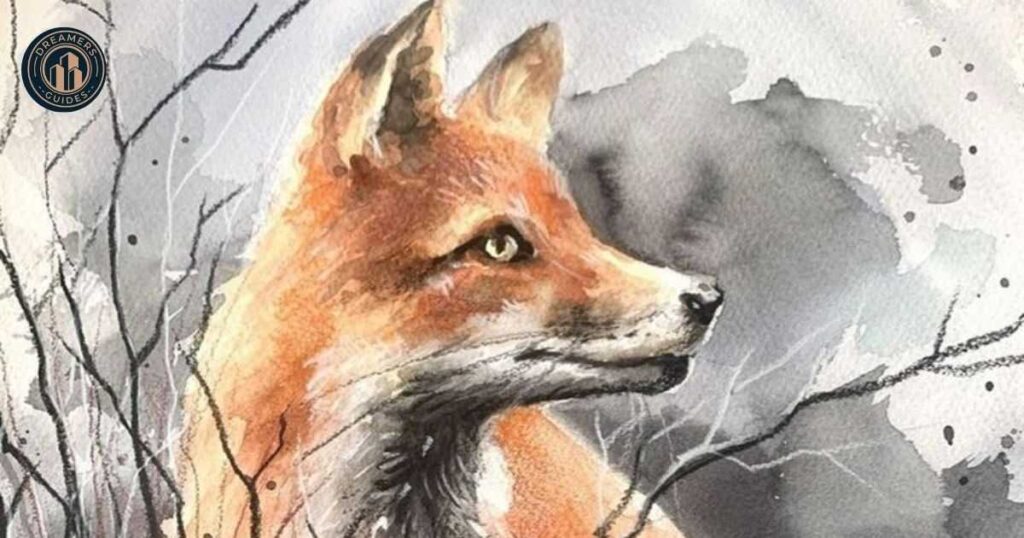In the rich tapestry of world mythology and literature, few creatures have captured human imagination quite like the fox. What does a fox symbolize in literature? From ancient tales to modern stories, these fascinating creatures represent a complex web of meanings that have evolved across cultures and time.
To understand what does a fox symbolize in literature, one must explore its portrayal in fables and folklore.
Fox mythology weaves through countless cultures, shaping our understanding of these intelligent creatures. Their presence in stories spans continents and centuries, from the crafty Reynard of medieval Europe to the mystical nine-tailed kitsune of Japan.
These tales reflect not just our observations of real foxes, but our deepest hopes, fears, and understanding of the natural world.
Symbolism of Fox in Literature
The role of foxes in literature reveals fascinating patterns across different cultures, often delving into themes of cleverness and deception. When examining what a fox symbolizes in literature, we find recurring motifs tied to cunning and wisdom, reflecting the duality in animal symbols that balances both virtuous and deceptive qualities.
Authors throughout history have utilized fox characters to unravel complex moral questions and explore human nature. Many readers ponder what does a fox symbolize in literature, often associating it with cunning and cleverness.
From Aesop’s clever fox to modern interpretations in contemporary fiction, these creatures continue to captivate readers and writers alike. Their presence in animal folklore in Europe frequently emphasizes intelligence, as seen in Reynard the Fox tales, which use the cunning fox archetype to critique societal norms and behavior.
Foxes embody an essence of transformation myths as well, often shifting between roles as helper and hindrance, and echoing fox trickery in folklore to underscore the subtleties of human nature.
In Japanese fox folklore, Kitsune fox spirits are mystical beings with shapeshifting powers, symbolizing both loyalty and guile. This duality, seen in Kitsune shapeshifting as well as fox deception in myths, symbolizes the thin line between wisdom and trickery.
Meanwhile, ancient Chinese legends view foxes as seductive and dangerous, often representing a blend of beauty as a weapon and untrustworthy magic, further reflecting dual nature in fox symbolism.
In Finland, foxes are seen as symbols of both intelligence and fortune, with legends like Tulikettu, the firefox, who embodies fortune and cleverness. Here, as in other traditions, foxes capture the untamed spirit of the wild, illustrating the tension between intelligence animal symbols and primal instincts.
The symbolism of fox as a trickster and sage endures, showing how literature uses this complex animal to represent the richness of the human experience. In various tales, the question of what does a fox symbolize in literature reveals deeper themes of deception and adaptability
Examples of Fox as Symbolism in Literature
Example #1: Aesop’s Fables
In ancient Greece, cunning fox folklore took center stage in Aesop’s timeless fables. The fox’s famous encounter with the sour grapes has become a universal metaphor for rationalization when facing failure. This story exemplifies how what does a fox symbolize in literature often relates to human psychology and behavior.
Example #2: Japanese Kitsune Tales
The Kitsune fox spirit represents one of the most sophisticated developments of what does a fox symbolize in literature. These legendary creatures possess nine tails, marking their wisdom and power.
In Japanese literature, kitsune often appear as shapeshifters who can take human form, usually as beautiful women. Their stories explore themes of loyalty, wisdom, and the complex relationship between humans and the supernatural world.
Example #3: Native American Fox Stories
Native American traditions view foxes as sacred messengers. Animal spirits in folklore feature prominently in their stories, where foxes often serve as spiritual guides. These tales emphasize the fox’s role as a teacher, helping humans understand natural wisdom and the importance of living in harmony with nature.
Example #4: European Medieval Fox Tales
Reynard the Fox tales dominated medieval European literature, offering sharp social commentary through animal characters. These stories featured Reynard as a clever trickster who outsmarted powerful but dim-witted wolves and bears, representing the triumph of wit over brute force.
Through these tales, authors could safely criticize social hierarchies and political corruption.
Example #5: Modern Literary Foxes
Contemporary literature continues to draw on traditional fox symbolism dual nature. Modern authors use fox characters to explore themes of environmentalism, identity, and social change. From children’s books to literary fiction, foxes remain powerful symbols of adaptation and survival in a changing world.
Fox Symbolism
1. Trickery
Fox trickery in folklore represents one of the most enduring aspects of vulpine symbolism. Stories across cultures portray foxes as master manipulators, using wit rather than strength to achieve their goals. This association stems from the fox’s natural hunting behavior and ability to evade predators through clever tactics.

In many societies, deceptive animals in folklore serve as teaching tools, helping people understand the complexities of human nature. The fox’s trickster nature often carries a dual message – warning against deception while simultaneously admiring resourcefulness and adaptability.
Read More About : Everything You Need About Mars in Aries: The Fiery Warrior
2. Transformation
Fox transformation myths appear consistently across world mythology. These stories often feature foxes changing into human form, particularly in Asian folklore. The concept of transformation connects deeply with human desires for change and adaptation.

Tales of Kitsune shapeshifting particularly emphasize this aspect, showing how foxes gain additional tails and powers as they grow in wisdom and age. This symbolism reflects human aspirations for personal growth and spiritual development.
3. Deception
The theme of deception in myths runs deep in fox folklore, transcending mere trickery to embody complex moral implications and spiritual teachings. In many cultures, the fox is seen as a deceptive figure, using cunning as both a means of survival and a moral lesson.
In Chinese legends, fox spirits often deceive humans to convey critical messages about human flaws, such as greed or pride, and their consequences.
The fox, with its notorious guile, reveals deeper lessons in animal folklore; these stories highlight the fox’s unique role in symbolism, where intelligence and duality are juxtaposed with dark undertones of mistrust.
In Japanese folklore, the kitsune a shapeshifting fox spirit is both revered and feared for its ability to assume human forms, specifically that of a beautiful woman, using deception to teach the unsuspecting the value of vigilance.
The fox’s cunning thus becomes a powerful symbol across cultures, emphasizing the importance of both wisdom and caution.
4. Fertility
Fertility symbols in animals often connect to fox imagery, particularly in East Asian cultures. The fox’s association with fertility stems from its den-making habits and the careful nurturing of its young, symbolizing abundance and nurturing in many traditions. In Japanese fox folklore, for example, kitsune (fox spirits) are sometimes seen as protectors of fertility and bringers of good fortune.
These animal spirits are revered for their role in maintaining prosperity and are believed to attract fertility to both land and people. Similarly, Chinese legends tell of fox spirits that, through their enchanting beauty, foster relationships that contribute to prosperity and abundance.
Even in Western cultures, foxes have been associated with prosperity and intelligence, highlighting their cleverness as a means to thrive and endure. This universal symbol of the fox connects deeply to life, fertility, and abundance across cultures.
5. Duality
Fox and duality in cultures presents a fascinating study in contrasts. Foxes embody both positive and negative qualities, representing the yin-yang of nature. They can be both helpful guides and dangerous tricksters, reflecting life’s inherent complexities.
6. Intelligence
Intelligence animal symbols find their perfect embodiment in fox tales. In Finnish mythology, fox intelligence myths demonstrate how clever thinking trumps raw strength. The fox’s reputation for quick-witted problem-solving has made it a universal symbol of wisdom and strategic thinking across cultures.
These stories often show foxes outwitting larger predators, teaching valuable lessons about using one’s intellect. From Native American legends to European fables, foxes represent the triumph of mental agility over physical might.
7. Fortune
Symbolism of fortune fox plays a significant role in Asian cultures. The Japanese Inari fox serves as a messenger of prosperity and good fortune. In Chinese traditions, fox spirits in Asia can bestow wealth and success upon those who honor them properly.

8. Cleverness
Cunning animal symbols reach their peak in fox-related stories. This cleverness differs from mere intelligence, representing practical wisdom and street smarts. The fox’s ability to adapt and survive in diverse environments has made it a powerful symbol of resourcefulness.
Read More About : Butterfly Meaning, Symbolism & Significance in World Culture
9. Protection
Sacred animal fox myths often portray foxes as protective spirits. In some cultures, foxes guard temples and sacred spaces. The concept of fox as a spirit guide appears in shamanic traditions worldwide, where foxes help humans navigate both physical and spiritual realms.
10. Wisdom
Fox symbolism throughout history is rich and varied, reflecting both its cunning nature and its embodiment of wisdom and transformation. In Japanese folklore, the multi-tailed kitsune is believed to gain wisdom with each additional tail, symbolizing the accumulation of knowledge and spiritual power.
This aligns with Finnish mythology, where foxes are depicted as clever and resourceful animals that rely on experience and intellect rather than brute strength, embodying the triumph of intelligence over power.
Across cultures, foxes are seen as tricksters, with the Kitsune fox spirit known for its shapeshifting abilities, often turning into beautiful women to deceive or even aid humans. Similarly, tales from Africa and Europe feature foxes as cunning beings, sometimes associated with deception and fortune.
The duality of the fox in these myths, embodying both light and shadow, highlights its role as a symbol of the untamed spirit of the wilderness and ancient mythological animals that convey deep, complex meanings.
.
The Cultural Significance of Foxes
Fox symbolism in cultures varies dramatically across different societies. In Eastern traditions, foxes often hold semi-divine status as mystical animals in history. Western folklore typically emphasizes their clever nature, though sometimes with negative connotations.

These cultural interpretations have evolved over time, reflecting changing human relationships with nature. Modern conservation efforts have added new layers to fox symbolism, highlighting their importance in ecosystem balance.
Here’s a detailed breakdown of fox symbolism by region:
| Region | Symbolic Meaning | Cultural Impact | Notable Stories |
| East Asia | Divine Messenger | Religious/Spiritual | Nine-tailed Kitsune |
| Europe | Clever Trickster | Social Commentary | Reynard Cycles |
| Americas | Wisdom Teacher | Tribal Knowledge | Coyote-Fox Tales |
| Africa | Sacred Messenger | Spiritual Guide | Dogon Fox Spirit |
| Arctic | Survival Guide | Practical Wisdom | Inuit Fox Woman |
Foxes in Mythology and Folklore
The intersection of witchcraft and fox myths reveals fascinating patterns across cultures. In medieval Europe, foxes were sometimes associated with witches’ familiars. Meanwhile, beauty as a weapon myths in Asian fox lore show how these creatures could use attraction for both good and evil purposes.
Consider this comparative table of fox symbolism across major cultures:
| Culture | Primary Symbolism | Key Characteristics |
| Japanese | Spiritual Power | Shape-shifting, wisdom |
| Chinese | Seduction | Beauty, deception |
| European | Cunning | Trickery, adaptability |
| Native American | Wisdom | Guidance, teaching |
| African | Message Bearer | Divine communication |
Fox in Myth and Reality: What Do They Symbolize
Animal folklore Europe contrasts interestingly with scientific observations of actual fox behavior. While real foxes demonstrate remarkable intelligence and adaptability, their mythological counterparts often possess supernatural abilities. This duality between fact and folklore enriches our understanding of these fascinating creatures.
The Thought-Fox Symbols, Allegory and Motifs
Fox mythology and yin-yang principles illuminate how these creatures embody natural balance. Their dual nature as both helpful and harmful spirits reflects deeper truths about the complexity of existence. The fox’s role in literature and myth continues to evolve, adapting to contemporary concerns while maintaining ancient symbolic resonance.
Psychological Symbolism Table:
| Aspect | Meaning | Modern Application |
| Shadow Self | Hidden desires | Personal growth |
| Trickster Archetype | Life’s chaos | Adaptation skills |
| Wisdom Guide | Inner knowledge | Self-discovery |
| Natural Intelligence | Practical solutions | Problem-solving |
| Transformation Agent | Personal change | Life transitions |
Read More About : Skull Symbolism & Meaning: Ultimate Guide
Key Takeaways
Understanding what does a fox symbolize in literature reveals universal human experiences and values. Key aspects include:
- Intelligence and adaptability
- Transformation and change
- Balance between good and evil
- Wisdom through experience
- Protection and guidance
Conclusion
Fox symbolism remains deeply relevant in modern times. Whether through ancient beliefs about foxes or contemporary interpretations, these creatures continue to fascinate and inspire. Their enduring presence in human culture speaks to their power as symbols of intelligence, adaptation, and the mysterious forces of nature.
The fox’s journey through human consciousness, from Inca Empire fox symbolism to modern media representations, shows how animal symbolism evolves while maintaining core meanings. As we face modern challenges, the wisdom embedded in fox symbolism offers valuable insights into creativity, adaptability, and the delicate balance between civilization and wildness.

James Michael
James Michael is the creative force behind Dreamers Guides, dedicated to exploring the rich symbolism and spirituality of diverse cultures. With a passion for uncovering ancient wisdom, He crafts insightful narratives that connect beliefs and foster understanding among readers worldwide.